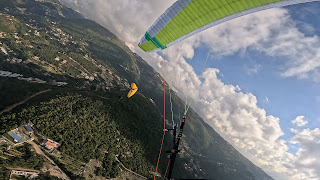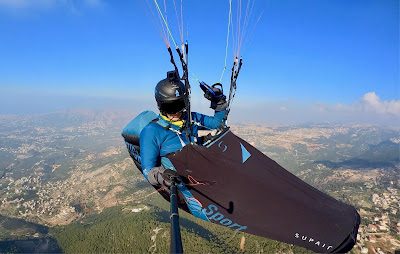Ozone Submarine M size
Ozone released a harness for minimizing the drag produced by the pilot/harness combination, and the main purpose is the extra glide angle in competitions.
I received one Submarine in `M’ size for a test flight.
The base harness is an exoceat that has been modified a bit. A thick wooden seat board is installed, and the chest strap width is fixed at around 50 cm. My personal feel and imagination, look like it is made to fit a pilot in a ‘Formula 1’ seating position!
The soft envelope surrounds the harness and both hands are inserted like wearing a jacket with also a Zipper that comes from the end of the pod to the cockpit, and another one from the cockpit or the main deck to be secured at the pilot's neck exactly like zipping your warm jacket. The air enters by the front and when it inflates in this efficient aerodynamic shape, only the pilot's head and arms can be seen outside the Submarine.
To reach that aerodynamic streamlined shape, you must adjust all the side and front adjustments to keep it horizontal while being convenient for your liking. Ozone made a very nice video following that link ( https://flyozone.com/paragliders/products/harnesses/submarine ) explaining how it is done. But for sure, to sit in that harness, you must be a hard-core resilient competition pilot with one focus on the finish line.
The harness weighs around 8.3 kg for the M. There are two side rescue pockets, rather small pockets to fit a normal rescue with a bit of patience.
The triple -Bullet-pedal accelerator has a long cord, that should pass through the riser pulleys of your competition glider while you need to remove the original Dyneema line on the risers or at least wrap it around the riser. The video and pics show it well.
I spent a whole day trying to find the best comfortable and horizontal position to my liking, and finally, I succeeded. The next day, was to try it in 30 km’h windy take-offs, which to my surprise was really easy while holding the rear end under my arms before launch. My buddies were amused taking some pictures :-) attached…
Overall, when you get used to it, it’s easy to take off and land like any other harness out there. It’s just the time preparing it to fly that has to be a bit tricky. There are two cockpits to install the higher cockpit holds the flying instruments that can be seen through the plastic window, and the lower cockpit can also hold lots of instruments and a 5 kg water ballast.
In the air, the Submarine feels and looks exactly like a Submarine !! :-) As only the pilot's head is outside with his eyes near the long front surface, the air feels really smooth! That’s a description all the Submarine pilots would feel! The sound of the wind is calmer and the impression you get is a smooth aerodynamic efficiency…At least that’s a first feeling…
Later I flew with my friend both of us on Zeno 2 and the same size and same load. My friend with the Submarine M size and I’m on my X-rated 6.
I really don’t want to get into lots of discussions and that’s just my small humble opinion.
On trim glides and about 5 km, I didn’t see any difference. Above 53 km/h there’s a very slight improvement for the Submarine after 5 km.
I think, for winning competitions you need to save every meter you gain after your long glides. So, 5 meters….10…15 meters…adding those meters after several glides could be your winning ticket to achieving your goals.
Conclusion:
I was amazed by the ingeniosity of that design. All the small details were studied to have that streamlined shape and efficiency. It is a bit delicate to handle, and landing on a tree isn’t a good idea and will eventually destroy the outside envelope. I don’t see how the rescue lines will pass near the collar without damaging the cloth…in case of a rescue opening. But it could happen without damage.
The difference in efficiency to gain gliding performance between a normal seated harness and a pod harness with rear fairing is greater than comparing the same pod harness with fairing to a Submarine.
But there’s a difference in speed and on long glides.
Every pilot will find a whole complete set of harnesses from pod to simple ones to his liking. The Submarine is a complex harness for a purpose.
If you are a very good competition pilot, and you need those extra meters that will help you get closer or be on a podium, then the Submarine is definitely for you if your competitors have a similar harness, then getting a high-end stream-lined harness like the Submarine, will keep you close in the game!












































